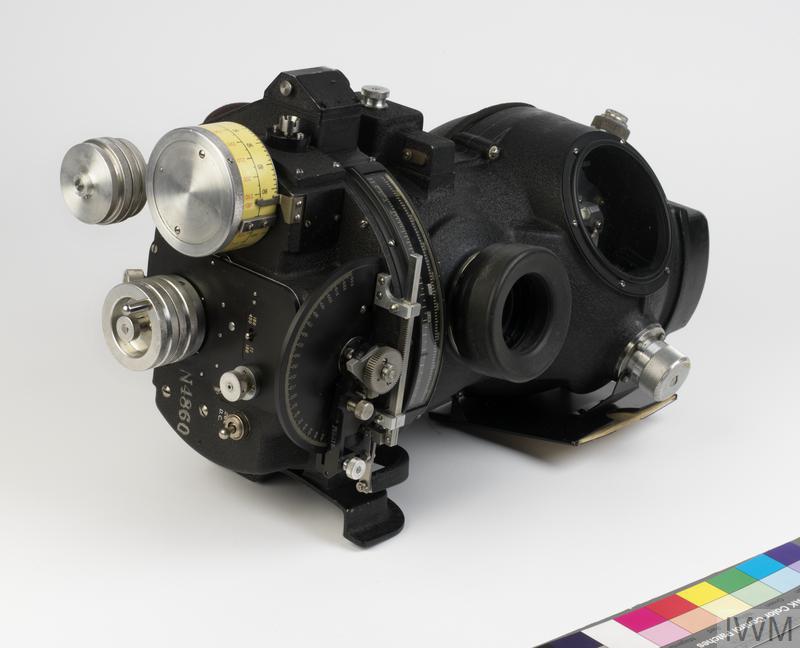

The AFCE could be used during the flight to the target area through a control panel in the cockpit, but was more commonly used under direct command of the bombardier. In USAAC use, the entire bombsight was attached to a second device, the "Automatic Flight Control Equipment" (AFCE), an autopilot system.

Norden Bombsight Conduct of a Mission, Army Air forces Film. The aircraft was moving over 110 meters per second (350 ft./s), so even minor interruptions in timing could dramatically affect aim. When the two met, the bombs were automatically released. In operation, the sight would be set far in advance of the aim point, and as the bomber approached the target the sighting point indicator would slowly slide toward the aim point. The current sighting point, where the prism was aimed, was also displayed against the same scale. The bombsight calculated the current aim point internally, and displayed this as a sliding pointer on the index. The second was the "index window" which displayed the aim point in numerical form. The first was the setting for "trail", which was pre-set at the start of the mission for the type of bombs being used. On top of the device, to the right of the sight, were two final controls. View from the Norden Bombsight sighting view. Another problem with the Norden is that the bombardier could only adjust either the vertical or horizontal aim at a given time, his other arm was normally busy holding himself up above the telescope.

As all of the controls were located on the right, and had to be operated while sighting through the telescope. The bombardier would begin making adjustments to the aim. Once the target was located the computer was clutched in and started moving the prism to follow the target. Later Nordens were equipped with a reflector sight to aid in this step.

The sighting prism would then be "clutched out" of the computer, allowing it to be moved rapidly to search for the target on the ground. Once the stabilizer was righted, the bombardier would then dial in the initial setup for altitude, speed and direction. This was accomplished in a time consuming process of comparing the platform's attitude to small spirit levels seen through a glass window on the front of the stabilizer. The sighting eyepiece was located in the middle, between the two.īefore use, the Norden's stabilization platform had to be "righted", as it slowly drifted over time and no longer kept the sight pointed "up". They were largely separate instruments, connecting through the sighting prism. The Norden bombsight consisted of two primary parts, the gyroscopic stabilization platform on the left side, and the mechanical calculator and sighting head on the right side. The mathematical principles are identical to those on the E6B calculator used to this day. These systems consisted of a slide rule-type calculator that was used to calculate the effects of the wind on the bomber based on simple vector arithmetic. Typical bombsights of the pre-war era worked on the "vector bombsight" principle introduced with the World War I Course Setting Bomb Sight. Norden Bombsight Principles, Army Air Force Film. The Norden was granted the utmost secrecy well into the war, and was part of a then unprecedented production effort on the same scale as the Manhattan Project. The Norden Bombsight at the San Diego Air and Space Museum.īoth the Navy and the AAF high-altitude bombing as a means to achieve war aims, without resorting to area bombing, as proposed by European forces. In practice it was not possible to achieve this level of accuracy in combat conditions, with the average CEP in 1943 being 370 meters (1,200 ft.). This accuracy allowed direct attacks on ships, factories, and other point targets. Together, these features allowed for unprecedented accuracy in day bombing from high altitudes in testing the Norden demonstrated a circular error probable (CEP) of 23 meters (75 ft.), an astonishing performance for the era. Key to the operation of the Norden were two features an analog computer that constantly calculated the bomb's trajectory based on current flight conditions, and a linkage to the bomber's autopilot that let it react quickly and accurately to changes in the wind or other effects. The Norden bombsight was a tachymetric bombsight used by the United States Army Air Forces (USAAF) and the United States Navy during World War II, and the United States Air Force in the Korean and the Vietnam Wars to aid the crew of bomber aircraft in dropping bombs accurately.


 0 kommentar(er)
0 kommentar(er)
